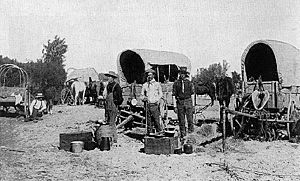Land Run of 1893 facts for kids
 |
|
| Date | September 16, 1893 |
|---|---|
| Location | Oklahoma, U.S. |
| Also known as | Cherokee Outlet Opening |
The Land Run of 1893, also known as the Cherokee Outlet Opening or the Cherokee Strip Land Run, was a huge event in American history. It was when a large area of land, called the Cherokee Outlet, was opened up for people to claim and settle. This happened in what would later become the Oklahoma Territory. It was the fourth and biggest "land run" in Oklahoma's history. This area eventually became part of the U.S. state of Oklahoma in 1907.
Contents
A Race for Land: The Land Run of 1893
Why the Land Was Opened
The Cherokee Outlet was a large piece of land that belonged to the Cherokee Nation. They had received this land in 1835 as part of an agreement called the Treaty of New Echota. This was after they were moved from their original homes.
Over time, many people wanted to settle on unoccupied lands in the area. These people were called Boomers. They pushed the government to open up these lands for settlement. Their efforts led to earlier land runs, like the Land Run of 1889.
In 1890, President Benjamin Harrison made an order that stopped all cattle ranching leases in the Cherokee Outlet. This meant the Cherokee Nation could no longer make money from renting out their land for cattle. Because of this, the Cherokee Nation agreed to sell these lands to the government. Many individual Cherokees were also allowed to claim land for themselves in the Outlet.
At the same time, many people were struggling. There were droughts, farm prices were falling, and the country was going through a tough economic time called the Panic of 1893. This made many people gather in camps in Kansas, hoping to get free land. Everyone was excited and nervous about the opening of this last big piece of land.
The Big Race Begins
The Land Run officially started at noon on September 16, 1893. About 100,000 people gathered, all hoping to claim a piece of the 6 million acres. There were about 40,000 homesteads (pieces of land for families) available. This was the biggest land run in Oklahoma's history.
To help manage the event, four special land offices were set up. These were in Perry, Enid, Woodward, and Alva. Soldiers were placed at these offices to keep order. Cavalry troops (soldiers on horseback) were also stationed nearby.
However, some people, known as 'Sooners', cheated. They snuck onto the land before the official start time. This allowed them to claim some of the best spots, especially in the eastern part of the Outlet and in the areas planned for towns. Because so many people wanted land, most participants did not actually get a claim for themselves.
What Happened After
After the run, several counties were created and named. These included Kay, Grant, Woods, Woodward, Garfield, Noble, and Pawnee. When Oklahoma became a state in 1907, four more counties were created from parts of these original ones. These new counties were Alfalfa, Ellis, Harper, and Major.
While some people found success, not everyone who claimed land became rich. Many of the new towns were built too quickly, and some farmers found that their land was not good for farming. Because of this, many land claims were given up by the end of the year.
The Land Run in Books and Movies

The exciting story of the Land Run of 1893 has been shown in many popular movies and books:
- Tumbleweeds, a film from 1925.
- Cimarron, a novel written by Edna Ferber in 1929.
- This book was made into two movies: Cimarron (1931 film) and Cimarron (1960 film).
- The New Frontier, a film from 1935.
- The Oklahoma Kid a 1939 film that tells a fictional story about the land run.
- The Thundering Prairie, a novel by M. A. Hancock from 1969.
- Far and Away, a film from 1992.




